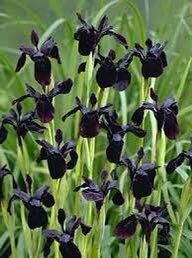Your Plant Bitch
Iris Chrysographes Seeds ~ Iris ‘Black Gold’ ~ Garden ~ Grow Your Own ~ Spring Flowers ~ Instead of Flowers
Iris Chrysographes Seeds ~ Iris ‘Black Gold’ ~ Garden ~ Grow Your Own ~ Spring Flowers ~ Instead of Flowers
Couldn't load pickup availability
The flowers are certainly not oil-coloured, but its name alludes to the Greek, chrysographes or ‘gold writing’. Tall strong stems hold sprays of darkest blue to almost black velvety flowers which are delicately marked with golden lines.
~ Includes ~
~ 5 Seeds.
~ Grow and Care Instructions.
✨ Follow Me ✨
Instagram: YourPlantBitch
Facebook: Your Plant Biitch
💕 Please come explore my site, YourPlantBitch, explore all of my new and exclusive collections. Rest assured, my main concern is my customers always!!! I try to provide the best customer service and strive to create a positive shopping experience for my customers. I’m always available to answer any questions or concerns you may have before and after your purchase. Custom orders are welcome!!! I can even include a handwritten gift card for no additional cost. Feel free to send me an offer, I will always do my absolute best to work with my customer’s offers. Contact me with any questions or if you’re interested in my sold~out items or need different quantities.
🩷Iris Grow and Care Instructions🩷
~ Grow Instructions ~
Store the seeds in a paper bag in a cool, dry place until autumn. Wait until several weeks of frost have occurred before sowing the iris seeds.
Soak the iris seeds in a bowl of water for three to five days. Change the water daily to prevent fungal infections and mold. Drain the seeds on a piece of paper towel for 20 minutes before sowing.
Sow the iris seeds in 6-inch pots filled with a moistened combination of three parts sterilized compost, two parts peat and one part perlite. Sow one seed per pot at a depth of one-half inch.
Place the pots outdoors under light shade. Overwinter them outdoors to break the seeds' natural dormancy, which weakens when exposed to cold temperatures.
Water the iris seeds thoroughly whenever the top quarter-inch of compost dries out. Maintain this level of moisture while the seeds overwinter outdoors. Avoid over-watering since constant exposure to soggy conditions will rot the seeds.
Watch for germination two to three months after sowing the iris seeds. Move them to a partly sunny area after germination. Continue to water regularly, but allow the top half-inch to dry out slightly between waterings.
Grow the iris seedlings under sheltered conditions until late spring, at least six weeks after the last spring frost. Transplant the seedlings into a sunny bed with moist, quickly draining soil.
*Tip*
Many iris seeds take several months or even years to germinate, so please don't discard the containers, if they fail to sprout in two to three months.
~ Care Instructions ~
- Fertilize in early spring with an all-purpose fertilizer scratched in around the plants. Avoid applying high-nitrogen fertilizers to the surface or carelessly mulching with organic matter, which may encourage rhizome rot. Reblooming Irises perform best if fertilized again after the first wave of flowering is finished.
- Do not overwater irises; too much moisture in the soil can cause the rhizomes (roots) to rot. Water consistently and deeply, especially during summer drought.
- Keep rhizomes exposed. Unlike bulbs, which thrive deep underground, iris rhizomes need a bit of sun and air to dry them out. If they’re covered with soil or crowded by other plants, they’ll rot. Irises may benefit from shallow mulching in the spring.
- Taller irises may need staking or they will fall over.
- Watch for iris borers in the foliage (dark vertical lines that may appear watery show up in the leaves). See pest tips below.
- Deadhead (remove spent blooms) consistently; Bearded Irises will flower sequentially on buds spaced along the stems.
- After blooming is finished, cut flower stems down at their base, but do NOT trim iris leaves after they have finished blooming. Leaves carry on photosynthesis and generate energy for next year’s growth. Cut off brown tips—and cut the flowering stalk down to the rhizome to discourage rot.
- After hard frost in the fall, cut foliage back hard, remove any foliage that appears spotted or yellowed and dispose of all debris in the trash.
- If iris foliage is hit with heavy frost, remove and destroy it to eliminate borer eggs. See your local frost dates.
- For winter protection, cover the rhizomes with an inch or two of sand topped with a light layer of evergreen boughs, applied after the ground freezes and removed when the Forsythias bloom the following spring.
- In the early spring, remove winter mulch and any old foliage to allow for fresh, new growth and prevent Iris borers.
Thank you so very much for supporting my small business!!! 🪴Happy Planting🪴
💚 Best Wishes, Your Plant Bitch (Quinn)
Share




















